

URB. Soundscapes : a historical approach. SOUNDSCAPES: A HISTORICAL APPROACH José Iges When talking about the origins of artistic interest in the sounds of the environment, apart from the instrumental descriptions of some baroque or romantic music, we have to go back to the beginnings of audio recording technology.

Furthermore, the idiosyncrasy of the most noteworthy authors refers us back to the first steps of the art of the radio. Walter Ruttman - Weekend. Active-listening. Max Neuhaus. Cage and Noise. Cage and Noise [1] Music.
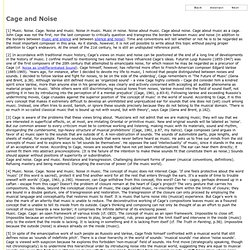
Noise. Cage. Noise and music. Noise in music. John Cage at Seventy: An Interview. John Cage hardly needs an introduction.
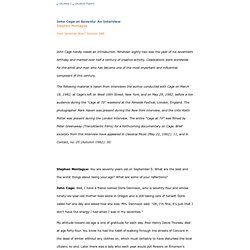
Nineteen eighty-two was the year of his seventieth birthday and marked over half a century of creative activity. Celebrations were worldwide for the artist and man who has become one of the most important and influential composers of this century. John Cage about silence. Music - Pierre Schaeffer. The Concept of „Sound Object“ (objet sonore) by Pierre Schaeffer. Pierre Schaeffer (1910 – 1995) is considered to be the founder of musique concrète.
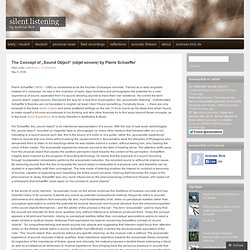
Trained as a radio engineer instead of a composer, he saw in the invention of radio, tape recorders and phonographs the potential for a new experience of sound, seperated from it’s source allowing sounds to have their own existence. He coined the term „sound object“ (objet sonore), that paved the way for a new kind of perception, the „acousmatic listening“. Unfortunately Schaeffer’s theories are not translated in english (at least I didn’t found something, if anybody know…), there are only excerpts in the book audio culture and some scattered writings on the net.
I’ll try to round up his ideas from what I found, to make myself a bit more accustomed to his thinking and why other theorists try to find ways beyond those concepts, as in the book Sonic Experience or in Andy Hamilton’s Aesthetics & Music. Pierre Schaeffer. “Photography, whether the fact be denied or admitted, has completely upset music …for all that, traditional music is not denied; any more than theater is supplanted by the cinema.
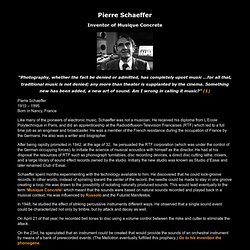
Something new has been added, a new art of sound. Am I wrong in calling it music?” Pierre Schaeffer 1910 – 1995 Born in Nancy, France Like many of the pioneers of electronic music, Schaeffer was not a musician. He received his diploma from L’Ecole Polytechnique in Paris, and did an apprenticeship at the Radiodiffusion-Television Francaises (RTF) which led to a full time job as an engineer and broadcaster. Luigi Russolo - The Art of Noises. Dear Balilla Pratella, great Futurist composer, In Rome, in the Costanzi Theatre, packed to capacity, while I was listening to the orchestral performance of your overwhelming Futurist music, with my Futurist friends, Marinetti, Boccioni, Carrà, Balla, Soffici, Papini and Cavacchioli, a new art came into my mind which only you can create, the Art of Noises, the logical consequence of your marvelous innovations.

Ancient life was all silence. Futurism: Manifestos and Other Resources. Luigi Russolo, Futurist: The Art of Noise and How the Occult Fueled Innovation in Music and Art. By Maria Popova What black magic has to do with John Cage and the secret of creativity.
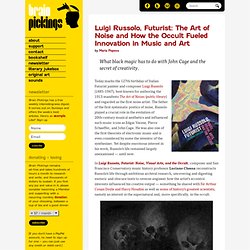
Luigi Russolo: How The Art of Noise Revolutionized 20th Century Music. Luigi Russolo at his Russolophone (1930) In 1913, a young Italian painter wrote an impassioned letter of admiration to composer Balilla Pratella after being witness to a performance of his symphony at the Costanzi Theatre in Rome: “While I was listening to the orchestral performance of your overwhelming Futurist music, there came to my mind the idea of a new art, one that only you can create: the Art of Noises, a logical consequence of your marvelous innovations.”
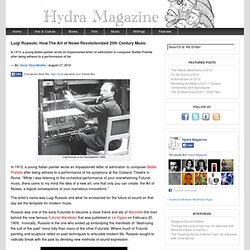
The artist’s name was Luigi Russolo and what he envisioned for the future of sound on that day set the template for modern music. Russolo was one of the early Futurists to become a close friend and ally of Marinetti–the man behind the now famous Futurist Manifesto that was published in Le Figaro on February 20, 1909.
BlindDate Promo. The World Listening Project. DEEP LISTENING INSTITUTE. Minute of Listening. Site-specific art. History[edit] Site-specifiс art emerged after the modernist objects as a reaction of artists to the situation in the world.
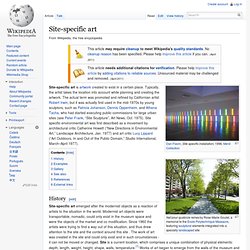
Modernist art objects were transportable, nomadic, could only exist in the museum space and were the objects of the market and co modification. Since 1960 the artists were trying to find a way out of this situation, and thus drew attention to the site and the context around this site . The work of art was created in the site and could only exist and in such circumstances - it can not be moved or changed. Examples[edit] Site-specific dance is also created to exist in a certain place. Bill Fontana – Finnieston Crane. Land art. History[edit]

Katie Paterson, Langjökull, Snæfellsjökull, Solheimajökull. Brandon LaBelle. Organ of Corti - full length version. ACOUSTIC ECOLOGY. During the 1970's, Steve Feld first began to sense the ways that some ideas from acoustic ecology, as expressed in Murray Schaffer's seminal The Tuning of the World, might inform and enliven his work as an emerging anthropologist of sound. Feld was especially taken with the suggestion that the creative interpretation and presentation of sonic field work is an important avenue of both intellectual exploration and public engagement.
Quite in contrast to the distinctly secondary role of recordings in most anthropology (as evidenced in generally low-quality source recordings and a relative lack of academic review and attention to audio "supplements" to written papers), Feld turned his musician's senses toward creating engaging, and eventually (as he prioritized it in his funding outreach) audiophile quality audio documents, beginning with first LP, Music of the Kaluli, in 1982.
By this time, Feld was committed to his somewhat iconoclastic approach to anthropology publishing. Tree Rings (2012) : YoonChungHan. Tree Rings (2012) Processing, Sound recording, Lasercut wood "Tree Rings" explores sound’s organic essence by visualizing it’s time dimension as a spiral series of tree rings, modulated by urban soundscape transcribed to waveforms. This piece highlights the natural harmonic beauty of sound - when used outdoors, the sounds of our renovated urban cityscape can be used to regenerate a relic of the natural landscape that was destroyed so that it could exist. Julian Treasure: The 4 ways sound affects us. Ocean Mammal Institute (OMI): Home Page. Manifesto - Ljudmiljöcentrum Lund University. (excerpt) Manifesto for a better acoustic environment The Sound Environment Centre at Lund University – is pleased to present a new edition of the MANIFESTO for a better acoustic environment (originally published in 1995 by the Royal Academy of Music).
Listening Against Soundscapes - Helmreich - 2011 - Anthropology News. AcousticEcology-11/AgainstSoundscape-AutumnLeaves.pdf. 52-1-stephanie-spray-in-focus. _Headphones_LMJ17.1-2007. Soundscape: Our Sonic Environment and the Tuning of the World: Amazon.co.uk: R. Murray Schafer. Dispersion of Sound Waves in Ice Sheets. The London Sound Survey featuring London maps, sound recordings, sound maps, local history, London wildlife. About — Recomposing The City. The Traveling Sound Museum. WORLD SOUNDSCAPE PROJECT. The World Soundscape Project (WSP) was established as an educational and research group by R.
Murray Schafer at Simon Fraser University during the late 1960s and early 1970s. It grew out of Schafer's initial attempt to draw attention to the sonic environment through a course in noise pollution, as well as from his personal distaste for the more raucous aspects of Vancouver's rapidly changing soundscape. Hildegard Westerkamp. Soundwalking. Soundwalking By Hildegard Westerkamp originally published in Sound Heritage, Volume III Number 4, Victoria B.C., 1974 Revised 2001 published in: Autumn Leaves, Sound and the Environment in Artistic Practice, Ed. Angus Carlyle, Double Entendre, Paris, 2007, p. 49. A soundwalk is any excursion whose main purpose is listening to the environment.
Listening in that way can be a painful, exhausting or a rather depressing experience, as our ears are exposed often to too many, too loud or too meaningless sounds. Unless we listen with attention, there is a danger that some of the more delicate and quiet sounds may pass unnoticed by numbed ears and among the many mechanized voices of modern soundscapes and may eventually disappear entirely. A soundwalk can be designed in many different ways. Soundwalkers. Janet Cardiff & George Bures Miller. Belfast Sound Map. X MARKS THE SPOT. Barry Truax. Guest Edition # 3 Jed Speare/Sven Anderson. This interview between artists Sven Anderson and Jed Speare took place on February 24th 2010 in the Mobius performance space in Boston.
It begins with a discussion of Speare’s early encounters with the disciplines of acoustic communication, ecology, and design at Simon Fraser University in 1978, after which it shifts through a series of Speare’s projects completed between 1982 and 2010. These projects operate across different social, conceptual, and geographical territories, articulating an acute environmental awareness coupled with an instinct to expand – rather than to reduce – throughout the evolution of each production.
………………I contacted Jed Speare in 2010 to see if he would be open to an interview focused on discussing some of his work in the context of my research at the time, which was focused on the use of site- specific, sound- based production strategies in urban space. SA: After that did you go immediately to SFU? JS: That was about two years later.